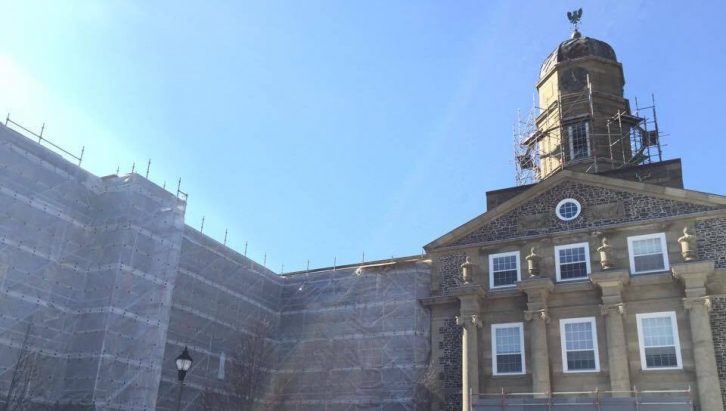Budget
DFA, DSU disappointed with Dal’s proposed budget
Tuition set to rise by 3%, faculty operating budgets cut by 1.9%

caption
Dalhousie's iconic Henry Hicks building is under construction
caption
Dalhousie University’s iconic Henry Hicks building is under construction.The unions representing Dalhousie University’s faculty and students both think the school is looking to save money in the wrong places.
Dalhousie is planning to cut its faculty funding for the 15th straight year, a move that dates back to 2002. The proposed 2017-18 budget is increasing from $404.3 million this academic year to $413.03 million. Tuition represents $158.9 million of the revenue, and faculty and service units represent $321.3 million of expenditures. It also calls for decreasing each faculty’s operating budget by 1.9 per cent, and raising tuition by three per cent.
Laurene Rehman, president of the Dalhousie Faculty Association (DFA), says the cut to faculty funding seriously affects their ability to meet the school’s teaching, research and service mission. The proposed cuts aren’t as bad as the five per cent the DFA expected, but the decade and a half of cuts have taken a toll on faculties. Related stories
“The first few years the faculties could absorb the cuts with fairly little impact on the mission, but now continuous erosion has led to the inability to hire tenured track faculty, inability to get students teaching assistants and sessionals and the inability to purchase equipment,” she said.
The school says it has taken these measures to account for inflationary costs and scheduled compensation increases for faculty and staff. According to the school’s website, expenses typically go up by 3 to 4 per cent annually, and are not offset by increases in provincial funding and tuition.
Rehman says cuts have been proposed to address capital expenditures and building new buildings, as well as supporting old ones. Additionally, all these new buildings will require continual upkeep and maintenance.
“Our concern is that decisions need to be made around putting up new infrastructure at the sake of teaching and research,” she said.
The school is currently restoring its Henry Hicks building, and developing a new fitness centre on campus.

caption
Dalhousie’s new fitness centre is under construction.DSU response
Dylan Ryan, vice-president of finance and operations at the Dalhousie Student Union (DSU), is also displeased with the new budget.
“Tuition is already high enough here, one of the highest in the country,” he said.
In his opinion, “the increase comes not because of pressures forcing it up, but market conditions that allow for it to increase.
“There’s no need for the income to be spent; it’s just that we could charge more, which is a disappointing way to look at how you pick a price for education.”
When asked to elaborate, Ryan talked about a presentation he made to the budget advisory committee when they compared Dalhousie to other U15 schools, an association of 15 of the top universities in Canada.
“You’re not comparing apples to apples in any of those cases,” he said. “In a lot of cases class sizes are smaller; there’s more money spent on materials for classes, (so) class conditions aren’t so poor.”
And since Dalhousie is cutting the faculty budget while increasing tuition, Ryan says that means “students are paying more for less.”
Ryan also brought up his concern for international students. Their tuition fees are high for the school — $18,699.06 for an international student in science compared to $9,234.06 for a Canadian student in the same program. However, they are quite low relative to international student fees at other Canadian schools. For example, University of Toronto charges over $40,000 for its international students.
Ryan says raising fees again, especially after increasing them so many times in the last decade, would be unfair to international students.
“When you see the raw cost of your tuition go up 30 per cent … it’s troubling,” he said.
He is also concerned for international students who have seen their tuition rise dramatically while they are at school, and may not be able to afford the increased cost.
“Are you in a position to leave? You’ve already invested all this money, but what’s two years of a degree worth?,” he said. “Absolutely nothing.”
Another hurdle that international students might face is a lack of funding from their home countries. Rehman says Dalhousie’s continuous cuts have hurt their product. The school is no longer a top 200 school in many rankings, so it isn’t always seen as a viable institution for scholarships.
Tough choices
Dalhousie is not the only university facing these tough choices.
For example, 10 out of the 21 Ontario universities saw their enrolment decline between 2014-15 and 2015-16, and last year the University of Manitoba had to work its budget around a projected $10.5-million shortfall. In the Maritimes, every university increased their tuition between this year and last.
Ryan is more concerned with his own school than other Canadian ones. He says in his four years working with the DSU, he has not seen a change in their communication with the budget advisory committee.
Rehman is a little more optimistic.
“When the budget has an impact on the mission and the university, the senate should have a chance to play a role in that decision,” she said. “We’re seeing that’s starting to happen more.”
The DSU is hosting a series of consultations for students to get their input on the proposed tuition hike.
The school also has an interactive page that lets anyone try to balance the budget.
